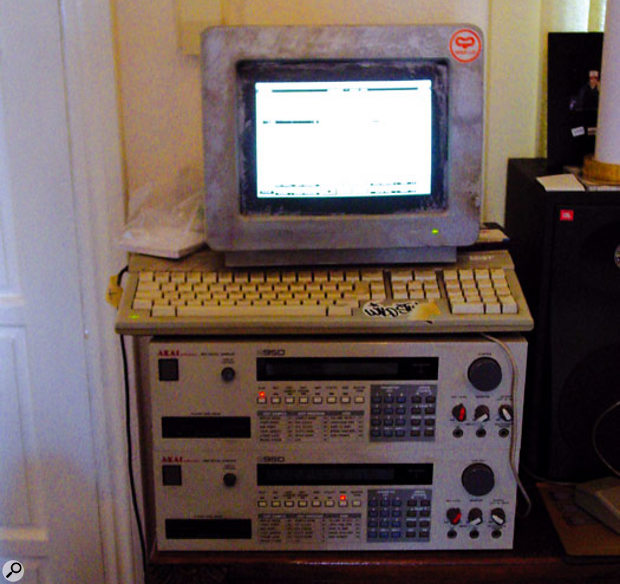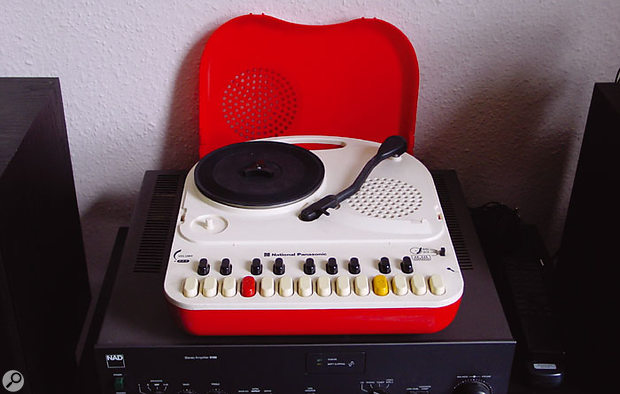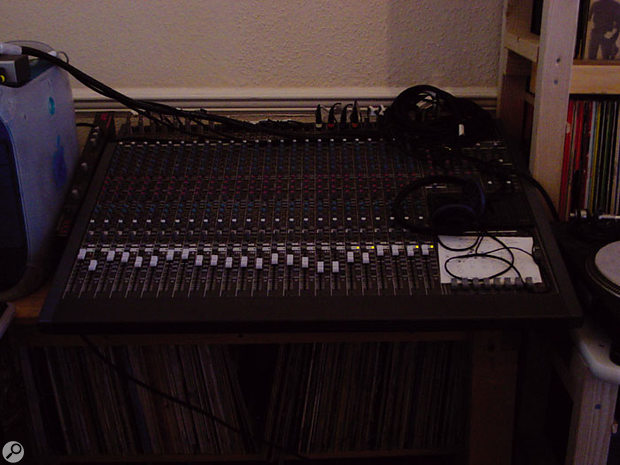DJ Format has been making funky, sample-led hip-hop since the old school was new — and it seems the world has finally caught up.
"UK hip-hop being cool is a very new thing," says Matt Ford. "I've been doing hip-hop since the early '90s, and I've worked with mainly English people. That was all great, but none of us were getting anywhere, and no-one was really interested."
They're certainly interested now: released under the name DJ Format, Ford's debut album Music For The Mature B-Boy has been one of the most successful British hip-hop records of recent years, and his second long-player If You Can't Join Them... Beat Them looks set for even bigger things. Yet as Ford acknowledges, his career only took off when he looked across the Atlantic for vocal talent. Both albums feature Canadian MC Abdominal on most tracks, with guest appearances from Jurassic 5's Charli 2NA and Akil. With Abdominal in particular, he feels he's found the perfect foil for his funky, old-school production style.
"I'm not a fan of much modern music, especially hip-hop," admits Ford. "You just hear someone, and you feel that their style would complement yours and vice versa, or you can see potential, or you can pretty much say outright that it's not going to work, and you can decide from there whether to pursue it. When I heard Abdominal's first record I was thinking 'I love the way this guy raps, he's got a lot of Big Daddy Kane's qualities that I think are missing in hip-hop at the moment. This really is going to suit the type of hip-hop I'm making at the moment.'"
Back To The Future
It's not only the sound of DJ Format's albums that is old-school: his approach to creating them would be equally familiar to any hip-hop producer of the late '80s or early '90s. Apart from the rapping, almost all the musical elements are spun from vinyl into two Akai S950 samplers, and triggered from Cubase running on an Atari ST. "Basically there's two responses when people find out that I use this equipment," laughs Matt. "They either think it's really fucking cool, or they think it's fucking hilarious — 'Why are you using that crap?'"
Unlike many hip-hop producers, Ford's motivation for using antique samplers has little to do with their 'special' sound quality. "I do like the sound that I'm getting, but it's mainly laziness and fear of new technology. With an MPC or an [Emu] SP1200, it's nice the way they really crunch up the beats. The SP12 will take drums and does something that almost nothing else will do, it crunches them down and makes them sound great. But as much as I appreciate how it crunches them up, for me personally, the way that hip-hop has gone over the last few years is that people have taken that technology and used the shit out of it. It just seems to be all unnatural beats that are very programmed, whereas I like to make my stuff funkier and have more of a live feel to it."
 The mainstay of DJ Format's studio: two Akai S950 samplers and an Atari, running Cubase.
The mainstay of DJ Format's studio: two Akai S950 samplers and an Atari, running Cubase.
DJ Format beats are rarely programmed as such: Ford will usually sample a one- or two-bar drum break in its entirety, and though these are invariably chopped into individual hits in the sampler, the point is not to change the rhythm in any radical way. "I generally like to reassemble the drums pretty much as they're played. If a beat's got a nice pattern to it and a nice feel to it, I pretty much want to replicate it, but tight. To the ear, no-one's going to think 'Oh, those drums are so regimented, it's too much,' like modern-day jiggy hip-hop — they keep their live feel, if you like, but they are completely chopped up, every kick drum, snare and hi-hat. I'll assign different hits onto different keys and sequence the rhythm from Cubase. It's not a case of 'Yeah, OK, just take a loop,' because that just doesn't work."
Much the same goes for bass lines and any other musical phrases. "The way I make music, people think that you just stick a loop on top of a loop. But of course if things have got bits of percussion and drum hits behind them, you've got to have them exactly hitting on point, or they're going to clash and sound awful. What I'll do is take the bass line, or whatever, and put it into the S950. Then I'll chop it up into as many pieces as I need to, and line it up with the metronome, and make sure that it's all in time. I'll chop it up into as many pieces as necessary, and then piece it back together again within the sampler and arrange it in the Atari."
Burger King
"The most valuable piece of equipment, for me, is a portable record player — and that's not an exaggeration," says Matt Ford. "When I go out record shopping, I take a portable record player. The Sound Burger is the really collectable one that everyone wants, because it's so small and the sound quality is good. You put the record in and you can actually shut it down like a burger.
 The highly collectable Sound Burger.
The highly collectable Sound Burger."But to be honest, as much as sound-quality-wise they are the best, the one that I personally use is a Fisher-Price kids' one. I got my mate to fit a headphone socket where there was an electrical adaptor, and I don't want to tempt fate, but I've never broken a needle and I've never scratched a record with it. I used to waste a fortune, when I didn't have a fortune to waste, going out and buying a pile of records that looked good. Records might look good, but half the time they sound awful. I go out to shops and skip through loads of stuff until I find what I'm looking for.
 In Matt Ford's surprisingly large collection of portable record players, it's this modified Fisher-Price model that gets the most use.
In Matt Ford's surprisingly large collection of portable record players, it's this modified Fisher-Price model that gets the most use. National Panasonic portable record player.
National Panasonic portable record player."You go to most other countries in the world, and they'll have a record player in a second-hand record shop, and they'll allow people to use it within reason. I don't know what it says about our country that that's literally unheard-of, and if you do take a record player in, sometimes people will let you use it, but a lot of the time not — especially in London."
 Matt's Philips player.
Matt's Philips player.And what of that time-honoured source of sample fodder, the charity shop? "Charity shops aren't as fruitful as they used to be. I think it's something that everyone's on to, which makes it very difficult to find anything really good. I do occasionally do charity shops, but it's more odd record shops around the world."
Playing Patience
The skill in this style of production is not so much to do with technical wizardry as it is with judging what works with what — and, of course, in shopping for records in the first place. "There's an element of skill, but it's a lot about perseverance and patience, and a lot about luck," admits Ford. "You've got to have ideas in your head, and you've got to have the vision to think at least 'I should be looking for a guitar, or a bass, or some drums,' but ultimately it's more about patience. You've got to have the patience and perseverance to dig out all these interesting records in the first place, and you've got to have luck to find something good, because you can look for hours and get nothing. And then when it comes to putting stuff together, it's exactly the same. You can have the best intentions and the best ideas, but unless you actually have the perseverance, patience and luck to try the right things and make them work... Obviously it can vary, but I might play 100 records or more, just looking for one sample.
"Some records are utter shit but with one amazing track on, and with those it takes me two seconds. All I do is go straight to the good track — 'How does it sound? Does it work? No' — and I move on. With other records, there's so much good stuff on them, you might be trying stuff, and spinning it back and pitching it up and down, and you can spend hours adjusting and trying things out. Do I sit down and listen to an entire record from beginning to end? Never.
"You have a certain mentality when you're looking for certain things. You're listening out for some drums or a guitar or a bass that really jumps out at you. You just have to skip through and do what you can. The classic place to find a drum break is the start of a song, but you can always miss stuff if you don't skip through properly. It's the same with all the instruments. You'd never look through a record without checking the start of every song."
A typical DJ Format track will usually begin with a single sample that happens to catch the ear. Ford takes as an example the semi-instrumental 'Black Cloud', from his new album. "I found this bass line on my travels, and I thought 'There's some potential in that. That's a song right there, I've just got to find the other bits to go with it.' So then I'm digging around, same as usual, and I find a guitar twang and some little bits of percussion on another record. I'm listening to it thinking 'Hey, that might work with that bass line' — it's literally as simple as that. Obviously, you try stuff, and nine times out of 10 they're in the wrong key, but sometimes they're either right or you can make them right. And that was how that song started out. The drums are always easy, I've got millions of drums. It was a case of 'I've got the bass line — Oh my God, this guitar fits perfectly with it.' So I started by putting those two together and making them fit.
 Ford's records are organised into loose categories, depending on their sampling potential: "These are all records with really nice drum breaks on," he says, indicating one of the many racks. "I always keep drums separate. These are drum breaks and bass lines for up-tempo, B-boy stuff, and this pile here is similar, but more '80s old-school sounding drums — still up-tempo, but 110-115 rather than 120-130 bpm."
Ford's records are organised into loose categories, depending on their sampling potential: "These are all records with really nice drum breaks on," he says, indicating one of the many racks. "I always keep drums separate. These are drum breaks and bass lines for up-tempo, B-boy stuff, and this pile here is similar, but more '80s old-school sounding drums — still up-tempo, but 110-115 rather than 120-130 bpm."
"From there, I'm not some great musician, I don't think 'What the song needs now is a flute!' I just play around with stuff until I find something that fits. What I'll do is I'll have the track playing and then I'll be going through some horns and stuff, and if it's not in the right key, I'll try pitching it up or down on the deck. Sometimes it works, sometimes it doesn't. I'll sample a longer piece than I use. The way that I do my music, I want it to sound natural, like it was played that way, I don't want to play it like it's an obvious sample."
The original, central sample will usually dictate the tempo for the track. "If you've got a bass line or a guitar, you don't want to start fucking around with it too much, or it's going to lose how it sounds. I've probably selected that particular bass line or guitar because I love how it sounds the way it is, and I don't want to change it too much, I just want to merge it with other things. You can mess around with drums a bit more.
"The good thing about sampling is that sometimes you do things that musically aren't correct, but to the ear, they work. A musician would never play, for example, some of the things over 'Black Cloud', but to the ear they sound all right. For instance, I'm sure that the guitar that comes in halfway through is not quite in key. That's one that I spent so long fine-tuning in the sampler, just changing the pitch. I chopped it into different pieces and had to tune each one slightly. You might have to tune the second half of the sample lower than the first half for it to work in the track. You can do little time-stretches with the Akais, but it's very primitive. If you've got something really slow and you want to speed it up, you can probably get away with it, but if you've got something fast and you need to slow it down, forget it."
Going Live
At the time of writing, DJ Format and Abdominal are about to embark on a lengthy live tour with labelmates Little Barrie. The live show is, it seems, as old-school as the records: "Just two turntables and a mixer, and if I've got Abdominal or D-Sisive, they're on microphones, it's as simple as that. I'll cut dub plates on vinyl — I don't want to sound snobby, but it's the hip-hop way. I'll do whatever's best for the show. I'm the DJ, but I'm featuring these rappers, and if I go out and present a live show, a lot of the show is them at the front and me at the back. The least I can do is be a good hip-hop DJ and play it off vinyl. That's just how I was brought up — hip-hop, vinyl, decks. We might do a basic instrumental, or sometimes we'll do a special mix where I'll add some bits in, or on a dub plate I'll add a few things at the end of the vinyl so you can scratch it at the appropriate places."
New Old Ways
These days, the S950s and Atari have been joined by an Apple Mac G4 running Logic, but it's still the hardware samplers that do most of the work. The Mac is fired up where long samples are required, or where something — like the string sample from 'Black Cloud' — needs to be subjected to a more extreme EQ treatment than Ford's Mackie desk can provide. "It's still really important to me to use a desk when I'm doing the initial songs," admits Ford. "I've never quite been brave enough to go over to getting a laptop and doing it all internally. I do like being able to stand there and move controls, and I do still use my old ART effects unit."
 Each of the Akai samplers has eight outputs, routed into this Mackie mixer.
Each of the Akai samplers has eight outputs, routed into this Mackie mixer.
The Mac also comes into its own when it comes to marrying Ford's backing tracks with each rapper's vocals. "I'll have given them the song in the post on a CD, whether it's a loop or a pretty much finished track," explains Ford. "They write to it, we discuss it on the 'phone, I get to the studio, they lay it down. Obviously I'll have a bit of input, but ultimately I like to let people pretty much do their thing, within reason. Then I'll take the Pro Tools session disk and either take it to another studio, or mix the vocals at the studio and bring back an a cappella for me to work with. I could have done the entire song on the Atari, but when I get back, I need to put the a cappella into the Mac, put the entire song in and start rearranging it, deciding where the cuts are needed. That's where the Apple Mac comes in, especially with doing scratches — unless you want to do your scratches live, first time, no mistakes, you've got to record on a loop until you get it right."

